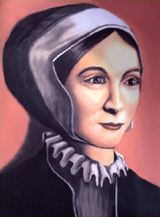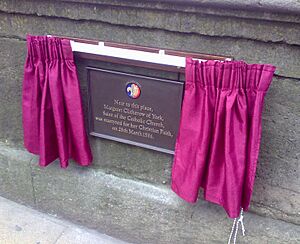Margaret Clitherow facts for kids
Quick facts for kids SaintMargaret Clitherow |
|
|---|---|
 |
|
| one of the Forty Martyrs of England and Wales | |
| Born | 1556 York, Yorkshire, England |
| Died | March 25, 1586 (aged 29–30) York, Yorkshire, England |
| Venerated in | Roman Catholic Church |
| Beatified | 15 December 1929 by Pope Pius XI |
| Canonized | 25 October 1970, Rome by Pope Paul VI |
| Major shrine | The Shambles, York, North Yorkshire, England |
| Feast | 30 August |
| Patronage | businesswomen, converts, martyrs, Catholic Women's League, Latin Mass Society |
Margaret Clitherow (born in 1556 – died March 25, 1586) was an English saint and martyr of the Roman Catholic Church. She is often called "the Pearl of York". She was put to death because she refused to say if she was guilty or innocent of hiding Catholic priests. She was made a saint in 1970 by Pope Paul VI.
Contents
Her Life Story
Margaret Clitherow was born Margaret Middleton in 1556. Her father, Thomas Middleton, was a respected businessman in York. He was also the Sheriff of York in 1564. Margaret was 14 when her father passed away.
In 1571, Margaret married John Clitherow, a rich butcher. They had three children together. Their family lived in a famous street called The Shambles in York.
Becoming Catholic
In 1574, Margaret decided to become a Roman Catholic. This was a difficult time in England because the official church was the Church of England, and Catholics faced many challenges. Even though her husband belonged to the Church of England, he supported Margaret. His own brother was a Catholic priest. John even paid the fines Margaret received for not going to the official church services.
Margaret was first put in prison in 1577 for not attending church. She was sent to York Castle two more times. Her third child, William, was actually born while she was in prison.
Margaret bravely risked her life by hiding and helping Catholic priests. She created secret rooms, called "priest holes," in her house. When her house was watched, she rented another house nearby to keep priests hidden and to hold secret Mass services. Her home became one of the most important safe places for priests in northern England. People say she also hid priests in the Black Swan Inn at Peaseholme Green, even when the Queen's agents were staying there.
Her Arrest and Death
Margaret sent her oldest son, Henry, to a college in Reims (now France) to train to become a priest. The authorities questioned her husband about why their son had gone abroad. In March 1586, Margaret's house was searched. A scared boy showed the searchers where a priest was hiding.
Margaret was arrested and brought before the court in York. She was accused of hiding Roman Catholic priests. Margaret refused to say if she was guilty or innocent. She did this to protect her children from having to testify against her and from being hurt.
Even though she was pregnant with her fourth child, Margaret was put to death on March 25, 1586. This day was also Lady Day and Good Friday. She was executed at the Toll Booth at Ouse Bridge. She was put under a heavy weight until she died. This was a way to force people to enter a plea.
The two officers who were supposed to carry out the execution hired four other people to do it instead.
After Margaret's death, Elizabeth I, the Queen of England, wrote to the people of York. She said she was shocked by how Margaret, a woman, had been treated. The Queen believed Margaret should not have been executed because of her gender.
Becoming a Saint
Margaret Clitherow was recognized as "blessed" (a step before sainthood) in 1929 by Pope Pius XI. She was then made a saint on October 25, 1970, by Pope Paul VI. She is one of the Forty Martyrs of England and Wales.
In England, their feast day (a special day to remember them) is May 4. Margaret is also remembered on August 30, along with other martyrs like Anne Line and Margaret Ward.
A special item, believed to be her hand, is kept at the Bar Convent in York.
St. Margaret's Shrine is located at 35-36 The Shambles. John Clitherow's butcher shop was at number 35. However, the street numbers changed later, so their actual home might have been across the street.
Her Legacy
St Margaret Clitherow is the patroness (a special protector) of the Catholic Women's League.
Many schools in England are named after Margaret Clitherow. You can find them in places like Bracknell, Brixham, Manchester, Middlesbrough, and London. There is also a school named after her in Loveland, Ohio in the United States.
She is also a co-patroness of the Latin Mass Society, which organizes a yearly trip to York to honor her. Several Catholic churches in the Roman Catholic Archdiocese of Liverpool have also united as a single community under her patronage.
The English poet and priest Gerard Manley Hopkins wrote a poem honoring Margaret Clitherow. The poem, called "Margaret Clitheroe," was found after his death. It celebrates her faith, courage, and how she died.
In 2008, a special plaque was placed at the Micklegate end of York's Ouse Bridge. This plaque marks the place where she was put to death. The Bishop of Middlesbrough unveiled it in a ceremony on August 29, 2008.
Images for kids
-
The shrine to Saint Margaret Clitherow on The Shambles, York, 2018
See also
 In Spanish: Margarita Clitherow para niños
In Spanish: Margarita Clitherow para niños




